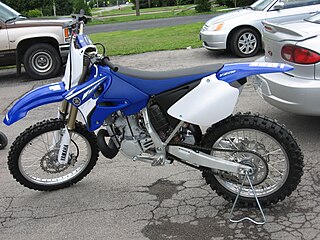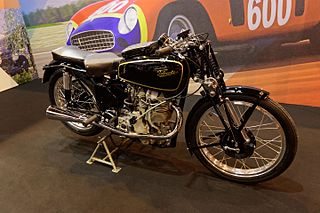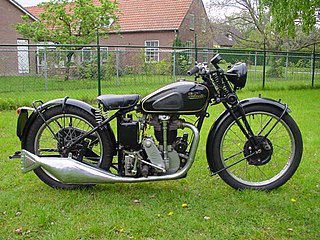
Velocette is a line of motorcycles made by Veloce Ltd, in Hall Green, Birmingham, England. One of several motorcycle manufacturers in Birmingham, Velocette was a small, family-owned firm, selling almost as many hand-built motorcycles during its lifetime, as the mass-produced machines of the giant BSA and Norton concerns. Renowned for the quality of its products, the company was "always in the picture" in international motorcycle racing, from the mid-1920s through the 1950s, culminating in two World Championship titles and its legendary and still-unbeaten 24 hours at over 100 mph (161 km/h) record. Veloce, while small, was a great technical innovator and many of its patented designs are commonplace on motorcycles today, including the positive-stop foot shift and swinging arm rear suspension with hydraulic dampers. The business suffered a gradual commercial decline during the late 1960s, eventually closing in February 1971.

The Kawasaki Ninja ZX-7R was a motorcycle in the Ninja sport bike series from the Japanese manufacturer Kawasaki produced from 1989 until 2003. It remained largely unchanged through its production. Kawasaki used inverted forks starting in 1991, added ram air using a single tube, and in 1996, twin tube ram air and Tokico six piston brakes and fully adjustable suspension. From 1989 through 1995 in the US market, Kawasaki called the ZXR-750 and ZXR-750R the ZX-7 and ZX-7R respectively. Starting from 1996 Kawasaki dropped the ZXR name worldwide and the former ZXR-750 was now ZX-7R and the limited edition homologation special ZXR-750R/ZX-7R started in 1991 was now ZX-7RR.

A swingarm, or "swinging arm" (UK), originally known as a swing fork or pivoted fork, is a single or double sided mechanical device which attaches the rear wheel of a motorcycle to its body, allowing it to pivot vertically. The main component of the rear suspension of most modern motorbikes and ATVs, it holds the rear axle firmly, while pivoting to absorb bumps and suspension loads induced by the rider, acceleration, and breaking.

Suzuki GSX-R750 is a family of 750 cc sports motorcycles from Suzuki's GSX-R series of motorcycles. Looking like a Suzuki Endurance racer, it can be considered to be the first affordable, modern racer-replica suitable for road use. It was introduced at the Cologne Motorcycle Show in October 1984.
A motorcycle's suspension serves a dual purpose: contributing to the vehicle's handling and braking, and providing safety and comfort by keeping the vehicle's passengers comfortably isolated from road noise, bumps and vibrations.

The next new Ducati engine to appear after the Ducati Apollo was the 90° V-twin, initial Grand Prix racing versions being 500 cc, and the production bikes were 750 cc. There was also the Ducati 750 Imola Desmo that won at Imola in 1972. These engines had bevel gear shaft drive to the overhead camshaft, and were produced in round, square, and Mille crankcases. In the 1980s these gave way to the belt drive camshaft engines that have continued to this day, in air-cooled and liquid-cooled form. The Mille used a plain bearing crank, like the belt models.

The Ducati Pantah was an Italian motorcycle with a 90° V-twin engine, produced between 1980 and 1986.
Robert Leslie (Les) Graham was a British motorcycle road racer who competed in the 1930s and 1940s. He won the inaugural Grand Prix motorcycle racing 500 cc World Championship in 1949.

The Ducati SuperSport and SS are a series of air-cooled four stroke desmodromic 2-valve 90° V-twin motorcycles made by Ducati since 1988. A limited edition SuperSport called the SuperLight was sold in 1992. The name harked back to the round case 1973 Ducati 750 Super Sport, and the 1975 square case 750 and 900 Super Sport. The appellation 'SS' was applied only to the later belt drive (Pantah) based models.

The Yamaha YZ250 is a two-stroke motocross race bike made by Yamaha. The model was launched in 1974 and has been regularly updated, and is one of the only two-stroke bikes of this displacement still in production, with new releases every year.

A motorcycle frame is a motorcycle's core structure. It supports the engine, provides a location for the steering and rear suspension, and supports the rider and any passenger or luggage. Also attached to the frame are the fuel tank and battery. At the front of the frame is found the steering head tube that holds the pivoting front fork, while at the rear there is a pivot point for the swingarm suspension motion. Some motorcycles include the engine as a load-bearing stressed member; while some other bikes do not use a single frame, but instead have a front and a rear subframe attached to the engine.
Motorcycle components and systems for a motorcycle are engineered, manufactured, and assembled in order to produce motorcycle models with the desired performance, aesthetics, and cost. The key components of modern motorcycles are presented below.
Harry Charles Lamacraft was an English motorcycle racer, most noted for successful exploits at the Brooklands racetrack and at the Isle of Man TT in the 1930s. He took tenth place in the 1934 Isle of Man Junior TT and tenth place in the 1935 Isle of Man Senior TT. In all, he rode in the TT 11 times, finishing above 19th place every time.

The Velocette Venom was a 499 cc single-cylinder four-stroke British motorcycle made by Velocette at Hall Green in Birmingham. A total of 5,721 machines were produced between 1955 and 1970.

The Velocette KTT Mk VIII is a British racing motorcycle made by Veloce, Ltd. who built motorcycles named the Velocette. The Mk VIII KTT was ultimate development of their K series of overhead-camshaft 350cc machines introduced in 1925, and the TT designation indicated a production racing motorcycle, and a near replica of the factory race team machines. Production continued until 1950.

The Velocette KSS is a British motorcycle made by Velocette. The final development of the K series The KSS remained in production in various forms until 1948.

Eugene Goodman was the co-founder of the Velocette motorcycle company with his father John Goodman.

The Velocette LE was a motorcycle made by Veloce Ltd from 1948 to 1971. The designation LE stood for "little engine". Used by over fifty British Police forces, the police riders became known as "Noddies" because they were required to nod to senior officers, and the LE was nicknamed "the Noddy Bike". Production ended in 1970 when the company ran into financial problems and went into voluntary liquidation.

The BMW R 80 G/S is a motorcycle that was manufactured in Berlin, Germany, by BMW Motorrad from 1980 to 1987. Production totalled 21,864 bikes. It was the first in the BMW GS family of specialised dual-sport bikes, of which over 500,000 have been produced, and is often considered the world's first "Adventure Bike" able to be equally as capable both on and off-road. The designation G/S stands for the German words Gelände/Straße, which mean offroad/road – highlighting the bike's dual sport design.
The Velocette Spring Heeled Jack is a motorcycle built by Velocette at Hall Green, Birmingham, England. This famous works KSS 350cc, sprung frame, Velocette was a prototype and as such the only one ever built by the Hall Green factory. The bike was christened Spring-heeled Jack by Harold Willis, and has been known by that name ever since by enthusiasts all over the world. First registered in May 1927, the motorcycle was a one-off built for Alec Bennett, the factory's number one rider, and was unsuccessfully tried in the practice sessions of the 1928 Isle of Man TT. This bike retained the factories hand change mechanism although the positive stop foot change was to be seen on the other race bikes of that year, and also had a straight through exhaust pipe.















